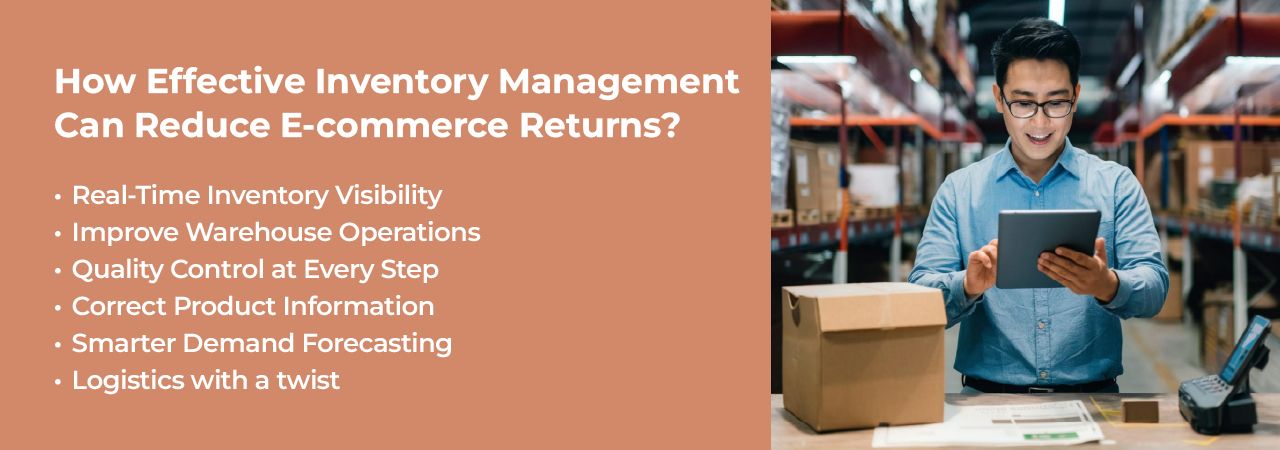Reduce E-commerce Returns with Smarter Inventory Management
Want to reduce e-commerce returns? Then start with your inventory. It’s that simple. Many e-commerce brands obsess over marketing and shipping. But they forget about the most crucial aspect which is inventory, if your inventory data is off, even by a little, you’re setting yourself up for a nightmare of returns, refunds, and frustrated customers.
What happens when inventory management is not efficient or accurate?
Customers purchase items that are sold out. They receive the wrong size or color. Or even worse, they got the correct product but were damaged from being mishandled or disorganized in the warehouse. All of which translate to higher returns, lost revenue, and eroded trust. Let’s dive into how poor inventory management snowballs into costly returns and what you can do about it.
How does Ineffective Inventory Management Affect E-commerce Return Management?
Inventory isn’t just about counting stock. Inventory management is more than that, it’s about whether your consumer gets the correct product at the correct time. When that process breaks down, returns surge, and every return blows away your profits and reputation.
Common Causes of e-commerce Returns
-
Defective or Damaged Product: This typically occurs due to improper warehouse treatment or long-term storage in overstocked conditions.
-
Customer Ordered Wrong Item: Sometimes this is associated with vague product descriptions or false information. The odds go down with clear, detailed listings.
-
Your Company Shipped the Wrong Product: This happens because of cluttered warehouses or uncalibrated picking processes.
The Real Cost of Bad Inventory Management
Returns are a natural part of e-commerce, but poor inventory control makes them spiral out of control. Let’s see how:
-
Mismatched Product Listings: When your inventory data isn’t synced with your online store, customers may order products that aren’t available or aren’t described as expected. This discrepancy is one of the biggest reasons for customer returns.
-
Late Fulfillment: Incorrect inventory delays order processing, which results in late delivery. Customers return late shipments frequently, especially for time-sensitive products.
-
Quality Control Issues: Overstocking can cause products to collect dust in the warehouse. This heightens the risk of spoilage or obsolescence that you might’ve avoided with better stock rotation.
What Happens When Inventory Management Goes Wrong?

-
Overstocked or Stockouts: With no real-time visibility into your WMS (Warehouse Management System), you’re fraught with guesswork, resulting in never-ending heaps of unsold stock or empty shelves when demand surges. In both situations, profits bleed and damage customer trust.
-
Slow Turnover Rates: Inventory that stays around for a long time locks up capital and incurs storage expenses. A slow turnover rate indicates low demand for your products and a mismatch between supply and demand.
-
Incorrect Financial Reporting: Inventory count mismatch leads to inconsistencies in cost accounting and revenue recognition. This not only misdirects decision-making but can also activate compliance risks.
-
Poor Demand Forecasting: Reliable historical data helps us forecast demands accurately, or it turns into daydreaming. You’ll just be ordering too much — or too little — gut instead of trends.
-
Operational Bottlenecks and Fragmented Systems: Disconnected platforms and manual workflows bog everything down. From late pick-pack-ship to burdening errors, inefficiencies set in and scale with every subsequent order.
-
Inventory Write-Offs: Obsolete or slow-moving inventory due to poor forecasting can lead to forced markdowns or total loss.
How Effective Inventory Management Can Reduce E-commerce Returns?

Looking to address e-commerce returns at the source? It begins with tightening your inventory game. Here’s how:
-
Real-Time Inventory Visibility: Get an accurate view of stock availability across all warehouses at any time. This allows you to avoid overselling, reduce backorders, and gain customer trust.
-
Improve Warehouse Operations: By optimizing picking and packing processes in a streamlined way, the chances of sending incorrect items are minimized. A well-managed warehouse = fewer errors.
-
Quality Control at Every Step: Inspection during receiving, shelving, and fulfillment can keep damaged items out of customers' hands.
-
Correct Product Information: Accurate product descriptions, high-resolution images, and videos allow customers to make an informed decision the first time around, so they won’t need to return a product later.
-
Smarter Demand Forecasting: Historical sales + trend analysis = the right products, in the right quantities, are ready to serve the customers.
-
Logistics with a twist: You fulfill orders fast, but also with precision. An efficient system guarantees customers receive what they ordered, on schedule, every time.
Strategies for Reducing Returns Through Inventory Improvements

That said, here’s a step-by-step action plan to reduce e-commerce returns before they occur:
- Enforce a Strong Return Policy: Implementing clear, concise, and fair return polices can set customer expectations.
- Regularly Audit Your Inventory Processes: Assess weak points in your operations, be it receiving, picking, or restocking. Having a proactive approach to fix these will serve you well.
- Use a Centralized Inventory Management Software like FulFillor: Let your sales channels meet an automated, organized, and centralized data for inventory tracking.
- Monitor Return Trends: Track what products get returned (and why) so you can get to the root of the underlying issues quickly.
- Use High-Quality Product Images and Descriptions: Ensure that customers are clear about what they’re purchasing.
E-commerce Return Management Best Practices
Successfully managing returns involves more than just inventory. Effective return management also needs to:
-
Streamlined Return Processes – Mirroring the streamlined return processes through easy-to-use, trackable return systems makes it easier for customers.
-
Proactive Customer Support – Assist in resolving issues before escalating to the point of returns.
-
Return Data Analysis – Know what makes the customers return a particular item.
How FulFillor WMS Helps You Reduce e-commerce Returns
A smart 3PL warehouse management system like FulFillor was built to prevent returns before they even begin. But how?
- Real-Time Inventory Monitoring: To ensure you never sell what you don’t own.
- Automated Order Fulfillment: To ensure that the right product goes to the right person, every time.
- Inventory Optimization Solutions: So that you don’t end up overstocked, understocked, and wasting a lot of money.
Real-World Success: A US-based e-commerce company was burning thousands of dollars per month on returns due to wrong inventory management. They relied on manual tracking, resulting in overselling, shipping errors, and damaged goods. In just 3 months of utilizing FulFillor’s modern 3PL WMS software, they saw a 25% drop in their return rate, thus saving costs and increasing customer satisfaction. With FulFillor, they went from chaos to control. And you can too.
Conclusion
Poor inventory management is a silent killer. From reducing profits to inflating returns to diluting your brand, poor inventory management has various other demerits. But it doesn’t have to be so.
With FulFillor’s 3PL WMS Software in place and by streamlining your inventory processes, you can reduce e-commerce returns as well as improve accuracy and live ahead of the disarray. The result? More satisfied customers, reduced expenses, and a stronger bottom line.
Want to decrease your returns and reclaim your margins?
Schedule your free demo of FulFillor today and see how smarter inventory management can transform your fulfillment operations.

